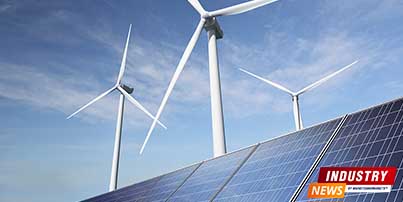Economic Analysis: The Shift Towards Low-Emission Fuels and Energy Efficiency Innovations

This News Covers
- Where and what are the shortfalls in clean energy investments
- Where is the money going in clean energy, what are the major investment buckets?
- Is the world closer to 1.5 degree breach?
- What are the top 5 industries affected by climate change?
- Which top countries are affected by climate change?
- How will AI affect renewables, electric vehicles, nuclear power, grids, storage, low-emissions fuels, efficiency improvements?
The International Energy Agency has announced recently that - and we quote them -
“Annual clean energy investment is expected to rise by 24% between 2021 and 2023, driven by renewables and electric vehicles, compared with a 15% rise in fossil fuel investment over the same period”.
MarketsandMarkets welcomes this development and our editors share their views.
There are clear shortfalls and while we are at the discussion about how upbeat clean energy investments look in 2023, we also take in to account some sobering facts.
The oil and gas industry’s capital spending on low-emissions alternatives such as clean electricity, clean fuels, and carbon capture technologies was less than 5% of its upstream spending in 2022. This highlights a shortfall in diversification efforts in these industries. Fossil fuel investment is expected to rise to more than double the levels needed by 2030 in the IEA’s Net Zero Emissions by 2050 Scenario. This mismatch between investment and climate goals signifies a significant shortfall in the shift to clean energy.
On the other hand, Artificial intelligence is revolutionizing various sectors, including the energy industry. From optimizing renewable energy generation to enhancing the efficiency of electric vehicles, improving reactor design in nuclear power, balancing power grids, refining energy storage, aiding the production of low-emissions fuels, and boosting energy efficiency, AI is reshaping the energy landscape. Leveraging AI can help tackle climate change, ensure more sustainable use of resources, and drive significant cost savings. Despite challenges in adoption and data security, the advantages of AI in this sector appear promising, leading the way towards a more sustainable and efficient future.
MarketsandMarkets analysts estimate that the global energy as a service market size was valued at $64.7 billion in 2022 and to reach $105.6 billion by 2027, growing at a compound annual growth rate (CAGR) of 10.3% from 2022 to 2027.
Where and what are the shortfalls in clean energy investments?
Here are some key shortfalls in clean energy investments:
- Geographical Disparities: A significant portion of the increase in clean energy investment is coming from advanced economies and China. This could result in new dividing lines in global energy if clean energy transitions don't pick up in other regions. Investment in clean energy is lagging in many emerging and developing economies.
- Unclear Policy Frameworks and Market Designs: In many developing economies, investment in clean energy is being hampered by unclear policy frameworks and market designs. This makes it more challenging for investors to predict and plan for the future, discouraging them from investing in clean energy projects.
- Weak Grid Infrastructure: Another significant challenge is the weak grid infrastructure in many countries. Without robust infrastructure, it is challenging to implement and use clean energy technologies efficiently and effectively.
- Financially Strained Utilities: In many places, utilities are under financial strain, making it harder for them to invest in new clean energy projects or to upgrade existing infrastructure to better accommodate clean energy.
- High Cost of Capital: In many developing economies, the cost of capital is high. This makes it more expensive to finance clean energy projects, discouraging investment in this area.
- Private Sector Reluctance: Much more needs to be done by the international community to encourage investment in lower-income economies, where the private sector has been reluctant to venture. This could include providing financial incentives, improving the regulatory environment, or providing technical assistance to reduce risks associated with these investments.
Where is the money going in clean energy, what are the major investment buckets?
Investment in clean energy is spread across various sectors. These sectors are often referred to as "investment buckets". Here are some of the major investment buckets in clean energy:
- Renewable Energy Generation: This includes investments in wind power, solar power, hydroelectric power, geothermal power, and other renewable energy technologies. These investments may cover everything from research and development to the construction and operation of renewable energy facilities.
- Electric Vehicles (EVs): The rise in popularity of EVs has led to increased investment in their production. This includes not only the manufacturing of the vehicles themselves, but also the development of better batteries, charging infrastructure, and other related technologies.
- Nuclear Power: Though controversial, nuclear power is a form of clean energy because it does not produce carbon emissions during operation. Investment in this sector can include the construction of new nuclear power plants, research into safer and more efficient technologies, and the management of nuclear waste.
- Grids and Storage: As renewable energy becomes more prevalent, there's a need for improved grid infrastructure and energy storage solutions. Investments can cover grid upgrades, the development of smart grids, and various forms of energy storage (like lithium-ion batteries, flow batteries, pumped hydro storage, etc.)
- Low-Emissions Fuels: These include biofuels and hydrogen, which can replace or supplement fossil fuels in various applications. Biofuels are derived from organic matter, while hydrogen can be produced from a range of sources, including renewable energy.
- Energy Efficiency Improvements: Investment in improving energy efficiency can have a significant impact on reducing energy use and emissions. This includes efficiency upgrades to buildings and industrial processes, more efficient appliances and equipment, and initiatives to improve energy use in transportation.
- Heat Pumps: As part of efforts to electrify heating and cooling, there's significant investment going into heat pumps, which can significantly reduce the use of fossil fuels for these purposes.
- Carbon Capture and Storage (CCS): This technology captures carbon dioxide emissions from power plants and other industrial sources, and then stores it underground to prevent it from entering the atmosphere.
Is the world closer to 1.5 degree breach?
As per the World Meteorological Organization (WMO), the world is indeed nearing the point of exceeding the 1.5 degrees Celsius warming threshold.
There is a 66% chance of temporarily reaching 1.5 degrees Celsius of warming within the next five years. This would be the first time that global temperatures exceed this threshold, even if it is a temporary occurrence.
However, it's important to distinguish between temporarily exceeding this threshold in a given year and consistently being above it when considering a longer-term average (30 years, as is common in climatology). The latter would represent a more serious breach of the 1.5 degrees Celsius limit set out in the Paris Agreement.
The increasing likelihood of reaching this level of warming in the near term indicates insufficient progress in reducing greenhouse gas emissions. Factors contributing to this imminent warming include both human-induced climate change and the potential development of an El Niño weather pattern, which naturally causes global temperatures to rise temporarily.
The WMO also predicts a 98% chance that one of the next five years will be the hottest on record, surpassing 2016, which experienced about 1.3 degrees Celsius of warming.
In light of these alarming predictions, organizations such as Greenpeace are urging for intensified global efforts to tackle the climate crisis. It is increasingly evident that substantial action to drastically reduce greenhouse gas emissions is urgently needed to prevent the most dangerous impacts of climate change.
What are the top 5 industries affected by climate change?
The following sectors, identified as the top five most susceptible to physical climate damage and the risks associated with transitioning to a net-zero economy, include:
Climate change significantly impacts various industries. The report by Deloitte highlights the top five sectors most vulnerable to physical climate damage and the risks associated with transitioning to a net-zero economy. These industries are:
- Agriculture: Climate change directly impacts agricultural activities by altering weather patterns, leading to increased incidents of droughts, floods, and heatwaves, all of which can devastate crops and livestock. Changes in temperature and precipitation patterns also affect the growth and distribution of pests and diseases, leading to further challenges for this industry. In addition, agriculture is a significant contributor to greenhouse gas emissions, especially through livestock and rice production, making it a focal point in the transition to a net-zero economy.
- Conventional Energy: This industry, which primarily includes oil, gas, and coal, is greatly affected by the global push towards decarbonization. Increasing regulations, technological advancements in renewable energy, and changes in market preferences are placing significant transition pressure on this industry. Additionally, these sectors are often located in regions vulnerable to climate events such as hurricanes, floods, and wildfires, which can disrupt operations and cause costly damages.
- Heavy Industry and Manufacturing: These sectors, including steel, cement, and chemicals, are significant contributors to global carbon emissions. Consequently, they face considerable transition risks as economies move towards net-zero emissions, including regulatory changes and increased costs associated with adopting cleaner technologies. Also, they often rely on steady climatic conditions and are prone to disruption from extreme weather events.
- Transport: Climate change impacts transport through extreme weather events, which can damage infrastructure and disrupt operations. Moreover, the transition to a net-zero economy entails a significant shift away from fossil-fuel-powered vehicles towards electric and other low-emission alternatives, posing substantial transition risks for the industry. Shipping and aviation, in particular, face challenges due to the current lack of viable low-carbon alternatives.
- Construction: This industry is vulnerable to climate change as extreme weather events can damage infrastructure, disrupt supply chains, and increase costs. Moreover, the construction sector is a significant contributor to global carbon emissions, both through the energy used in buildings and the emissions produced in the creation of construction materials like cement and steel. This industry thus faces considerable transition risk as regulations and market preferences shift towards greener building practices.
These sectors share common characteristics that make them vulnerable, such as high exposure to climatic extremes, a reliance on capital-intensive operations that can be disrupted by natural disasters, and a significant contribution to national income and economic growth derived from fossil fuel and energy-intensive production.
Which top countries are affected by climate change?
The countries most at risk of climate disaster, as identified by the International Rescue Committee (IRC) and the World Resource Institute (WRI), include those with high levels of fragility and low climate readiness. These countries often suffer the most from climate disasters despite contributing a minimal fraction to global greenhouse gas emissions.
- Somalia: Climate change has worsened the existing challenges of drought and food insecurity in Somalia, a country plagued by political instability. It is expected that by mid-2023, nearly half of the country's population will face crisis-level food insecurity.
- Syria: After a decade of war, Syria's capacity to respond to crises is critically eroded. Extreme drought and recent earthquakes have exposed the challenges of responding to disasters in such a fragile context.
- The Democratic Republic of Congo (DRC): The DRC suffers from persistent conflict, economic challenges, and disease outbreaks. These factors diminish the country's ability to prepare for climate disasters, including floods and rising food insecurity.
- Afghanistan: Afghanistan's fragility has increased since the Taliban's rise to power. The country now faces its third year of drought, and intense flooding in some areas has reduced food production and displaced people.
- Yemen: Years of conflict have sparked an economic crisis in Yemen, which is now further exacerbated by climate change-driven desertification and drought.
- Chad: The world's most climate-vulnerable country according to the Notre Dame-Global Adaptation Initiative Index. Flooding and economic crises have led to widespread food insecurity, and growing conflict has limited progress in building climate resilience.
- South Sudan: South Sudan, a country with high fragility and low climate readiness, is increasingly susceptible to climate disasters. Local conflicts and severe flooding have further jeopardized the country's stability.
- Central African Republic (CAR): The CAR's stability is under constant threat due to competition for control over political power and natural resources. Flooding and diseases pose significant threats to the already weakened healthcare system.
- Nigeria: Flooding has affected millions in Nigeria, causing extensive damage to farmlands and leading to widespread food insecurity. Political tensions and conflicts have hampered the country's ability to respond effectively to these climate disasters.
- Ethiopia: Ethiopia is facing an extensive drought that's affecting millions. The situation is expected to worsen as the country is predicted to experience its sixth consecutive failed rainy season. Conflicts and political instability have disrupted aid support and hindered authorities' ability to address the climate change impacts.
How will AI affect renewables, electric vehicles, nuclear power, grids, storage, low-emissions fuels, efficiency improvements?
AI can indeed play a significant role in various aspects of the energy industry, including renewables, electric vehicles, nuclear power, grids, storage, low-emissions fuels, and efficiency improvements. Here are some ways how:
- Renewables: AI can optimize the generation and distribution of renewable energy. For instance, it can predict weather patterns to forecast the output from wind and solar power sources. From optimizing the operations of renewable energy facilities, reducing costs to increasing efficiency, the use cases seem promising.
- Electric Vehicles (EVs): AI can be used to improve the efficiency of electric vehicles in several ways. For example, the charging times can be reduced and rates for electric vehicles could be based on patterns of use and electricity rates as also it could enhance battery management systems, improving their lifespan and performance.
- Nuclear Power: As the IAEA report outlines, AI can play a significant role in optimizing procedures, improving reactor design, performance, and safety, and even aiding in predictive maintenance. It can also assist in safeguards and security measures, helping to analyze large amounts of data and detect anomalies.
- Grids: One of the most underrated yet crucial aspects is to balance the supply and demand on the power grid more effectively, leading to increased reliability and efficiency. It can also help predict and mitigate outages, optimize power flow, and manage distributed energy resources.
- Energy Storage: We are already seeing startups wanting to tackle this challenge to optimize energy storage systems, determining the best times to store and release energy based on demand and price signals. This will certainly improve the economic value of energy storage and promote the integration of renewable energy into the grid.
- Efficiency Improvements: One of the holy grails of energy and power sectors have been finding inefficiencies in energy use, and providing recommendations for energy savings. This can be particularly valuable in industrial settings, where small improvements in efficiency can result in significant cost savings and reductions in greenhouse gas emissions.
While AI can offer many benefits to the energy industry, it is important to recognize that these technologies also pose challenges. For example, implementing such solutions often requires significant up-front investment, and there are also ongoing costs related to training and maintaining systems that themselves are energy intensive. In addition, issues related to data privacy and security must be carefully managed. However, with appropriate management and oversight, the benefits of AI to the energy sector are likely to outweigh these challenges.
References
GET AHEAD
Top Research Reports to Fuel Your Industry Knowledge- Energy as a Service Market by Type (Energy Supply Services, Operational and Maintenance Services, and Energy Efficiency and Optimization Services) End-User (Commercial and Industrial) and Region - Global Forecast to 2027
- Impact Investing Market by Illustrative Sector (Education, HealthCare, Housing, Agriculture, Environment, Clean Energy Access, Climate Change, Financial Inclusion, Rural Development, Sanitation & Waste Management), and Country - Global Forecast to 2020
Editor's Pick


Information and Communication Technology
Insurtech Funding News - Coverdash raises USD 13.5 Million
PODCASTS

Sustainable Digital Transformation & Industry 4.0
Sanjay Kaul, President-Asia Pacific & Japan, Cisco, and host Aashish Mehra, Chief Research Officer, MarketsandMarkets, in conversation on unraveling 'Sustainable Digital Transformation and Industry 4.0'
11 July 2023|S2E12|Listen Now

Generative AI
Prasad Joshi, Senior Vice President-Emerging Technology Solutions, Infosys, and host, Vinod Chikkareddy, CCO, MarketsandMarkets, in exploring the recent advances in AI and the generative AI space.
7 Nov 2023|S2E13|Listen Now
Energy as a Service Market
Download Whitepaper
Clean energy investments rise, but challenges hinder climate goals achievement.
AI transforms renewables, EVs, nuclear power, grids, and fuels efficiency.












